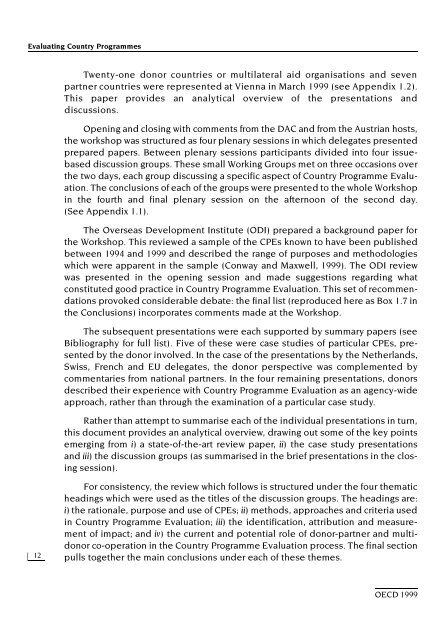Evaluating Country Programmes - OECD Online Bookshop
Evaluating Country Programmes - OECD Online Bookshop
Evaluating Country Programmes - OECD Online Bookshop
Create successful ePaper yourself
Turn your PDF publications into a flip-book with our unique Google optimized e-Paper software.
<strong>Evaluating</strong> <strong>Country</strong> <strong>Programmes</strong><br />
12<br />
Twenty-one donor countries or multilateral aid organisations and seven<br />
partner countries were represented at Vienna in March 1999 (see Appendix 1.2).<br />
This paper provides an analytical overview of the presentations and<br />
discussions.<br />
Opening and closing with comments from the DAC and from the Austrian hosts,<br />
the workshop was structured as four plenary sessions in which delegates presented<br />
prepared papers. Between plenary sessions participants divided into four issuebased<br />
discussion groups. These small Working Groups met on three occasions over<br />
the two days, each group discussing a specific aspect of <strong>Country</strong> Programme Evaluation.<br />
The conclusions of each of the groups were presented to the whole Workshop<br />
in the fourth and final plenary session on the afternoon of the second day.<br />
(See Appendix 1.1).<br />
The Overseas Development Institute (ODI) prepared a background paper for<br />
the Workshop. This reviewed a sample of the CPEs known to have been published<br />
between 1994 and 1999 and described the range of purposes and methodologies<br />
which were apparent in the sample (Conway and Maxwell, 1999). The ODI review<br />
was presented in the opening session and made suggestions regarding what<br />
constituted good practice in <strong>Country</strong> Programme Evaluation. This set of recommendations<br />
provoked considerable debate: the final list (reproduced here as Box 1.7 in<br />
the Conclusions) incorporates comments made at the Workshop.<br />
The subsequent presentations were each supported by summary papers (see<br />
Bibliography for full list). Five of these were case studies of particular CPEs, presented<br />
by the donor involved. In the case of the presentations by the Netherlands,<br />
Swiss, French and EU delegates, the donor perspective was complemented by<br />
commentaries from national partners. In the four remaining presentations, donors<br />
described their experience with <strong>Country</strong> Programme Evaluation as an agency-wide<br />
approach, rather than through the examination of a particular case study.<br />
Rather than attempt to summarise each of the individual presentations in turn,<br />
this document provides an analytical overview, drawing out some of the key points<br />
emerging from i) a state-of-the-art review paper, ii) the case study presentations<br />
and iii) the discussion groups (as summarised in the brief presentations in the closing<br />
session).<br />
For consistency, the review which follows is structured under the four thematic<br />
headings which were used as the titles of the discussion groups. The headings are:<br />
i) the rationale, purpose and use of CPEs; ii) methods, approaches and criteria used<br />
in <strong>Country</strong> Programme Evaluation; iii) the identification, attribution and measurement<br />
of impact; and iv) the current and potential role of donor-partner and multidonor<br />
co-operation in the <strong>Country</strong> Programme Evaluation process. The final section<br />
pulls together the main conclusions under each of these themes.<br />
<strong>OECD</strong> 1999

















![CQE=U]^\]Z: KAZAKHSTAN - OECD Online Bookshop](https://img.yumpu.com/3915768/1/190x253/cqeuz-kazakhstan-oecd-online-bookshop.jpg?quality=85)